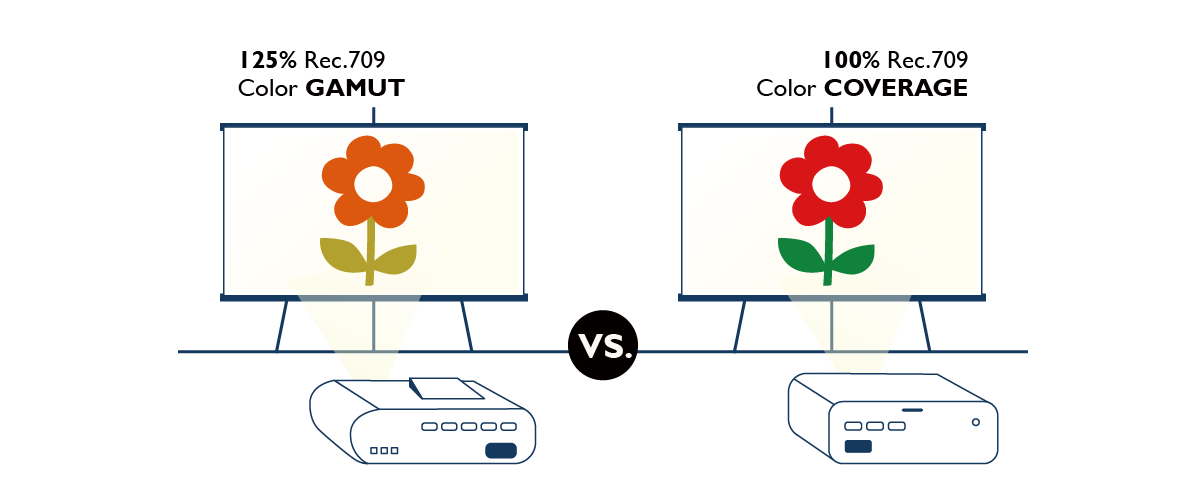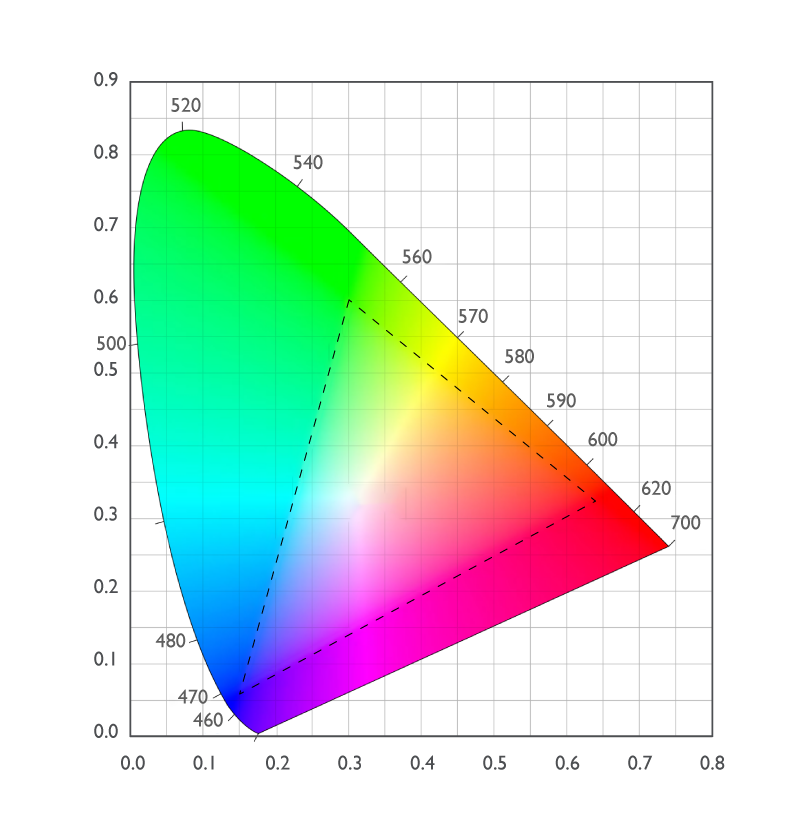Projector
Monitor
Lighting
Digital Display
Job References
When you’re in the market to buy a new projector, you want to make sure you’re getting a top performer at the price-level you set for yourself. For the diligent shopper, that means increased scrutiny on each potential purchase’s specs. Along with the more commonly known specs, such as resolution and brightness, one of the key areas you need to be attuned to in order to ensure that you get the level of performance you desire is its color. But with an array of brands advertising different kinds of color specs, how are you supposed to know which one to take seriously and which one to take with a grain of salt?

To answer this question, it’s best to run through some of the more commonly used terms and concepts related to color performance: color gamut and color coverage.

In the field of color reproduction, experts use the term color gamut to describe the range of colors within the overall spectrum of visible colors (also known as a color space) that an imaging device – in our case a projector – is able to reproduce; you can think of it as similar to a painter’s palette. As such, a projector with a wider color gamut is by definition able to reproduce more colors in the visible spectrum.
One of the most common methods used to visually represent a color gamut, is with a triangle drawn within the CIE color space diagram, where each corner of the triangle represents the purest red, green, and blue that the device is able to reproduce.
But given that projectors are just one type of device within the larger imaging ecosystem – an ecosystem that includes other devices such as cameras, displays, and so on – defining their color gamuts is not enough to describe their color performance. This is because the manufacturers of each type of device in the ecosystem need to make sure that every color in their devices’ color gamut are defined the same across the board, otherwise, when trying to reproduce the same image, each device would come up with different versions of each color. That’s where the Rec. 709 color gamut comes into play.

CIE 1931 color space
Rec. 709 is a color gamut developed by the ITU Radiocommunication Sector (ITU-R) that acts as a standard used by much of the high-definition display and projector industry to ensure that all the devices on the market that adopt it as their standard are on the same page in terms of color. In other words, by using a standard like Rec 709, manufacturers can share a common language for the colors they use, so that the "cherry red" one manufacturer uses is the same "cherry red" produced by another manufacturer.

With the Rec. 709 standard in hand many brands have found that one of the most convenient ways to characterize their product’s color gamut is as a percentage of the Rec. 709 color gamut. While doing so seemingly helps the consumer quickly understand the degree to which a device can reproduce the Rec. 709 standard’s colors, this kind of description for a color gamut can be easily misinterpreted, particularly when a brand advertises a color gamut that exceeds the Rec. 709 color gamut – such as 125% of Rec. 709. Because by advertising a color gamut with 125% of Rec. 709, the implied – but incorrect – message is that this device’s color gamut not only fully covers the Rec. 709 color gamut but also includes more colors.
The truth is that the claim that a color gamut 125% of Rec. 709 only means that the overall size of the respective product’s color gamut is over 100% the size of the Rec. 709 color gamut, it does not necessarily mean that said color gamut covers 100% of Rec. 709 plus an additional 25%. There can be many instances where 125% of Rec. 709 color gamut covers 90% or less of the Rec. 709 gamut, as seen in the image below.
The proper way of communicating how much of the Rec. 709 standard covered by a color gamut instead is through color coverage.

As mentioned above, a device with a color gamut that exceeds the Rec. 709 standard does not necessarily mean that it is able to reproduce all the colors in the Rec. 709 standard. Color coverage on the other hand better expresses a device’s capability to do so because it actually represents the percentage of overlap between the device’s color gamut and the Rec. 709 standard. So, a device with a color coverage of 95% of Rec. 709 is guaranteed to be able to reproduce 95% of the Rec. 709 color gamut accurately, while a product with over 100% of Rec. 709 might only be able to reproduce 90%.
Furthermore, color gamuts that exceed the size of the Rec. 709 standard but feature a lower than 100% color coverage will actually lead to issues with their color accuracy, including color deviation and oversaturation. This is due to the fact that because Rec. 709 is used as a standard to sync up colors across devices, any device whose color gamut features large chunks outside of the Rec. 709 boundaries – as is the case with devices that have large color gamuts but lower color coverage – will invariably produce colors that deviate from the colors produced by another device that has adopted the Rec. 709 standard. Similarly, oversaturation will also occur when the areas of a large color gamut that lie outside of the Rec. 709 boundaries skew towards a specific color, most commonly red.

As technology advances the ability for devices to represent more colors will require the industry to move to newer standards that encompass a wider swath of the visible spectrum than the Rec. 709 standard. In the movie industry, for example, the standard that is now used for color reproduction is the DCI-P3 color gamut – a color gamut that is larger than Rec. 709 – with the vast majority of high-end equipment in that industry requiring 100% color coverage of the standard.
Regardless of the standard adopted in the future though, a consumer looking for the highest performing projector in their price range should always keep their eyes out for color coverage to ensure the most accurate color reproduction.
{{title}}
We will notify you when we have more.
We will send you an email once the product become available.Your email will not be shared with anyone else.
Sorry, our store is currently down for maintenance.We should be back shortly. Thank you for your patience!
The requested qty is not available
The requested qty exceeds the maximum qty allowed in shopping cart
Product that you are trying to add is not available.
